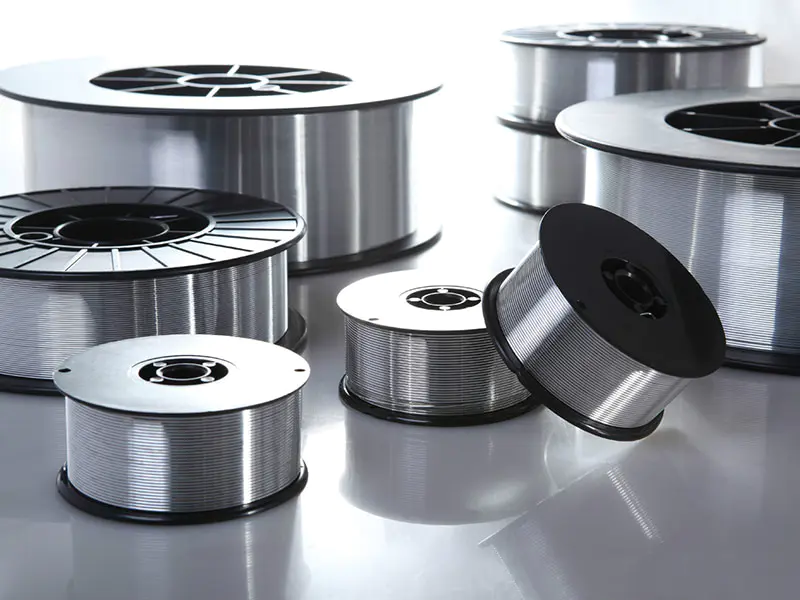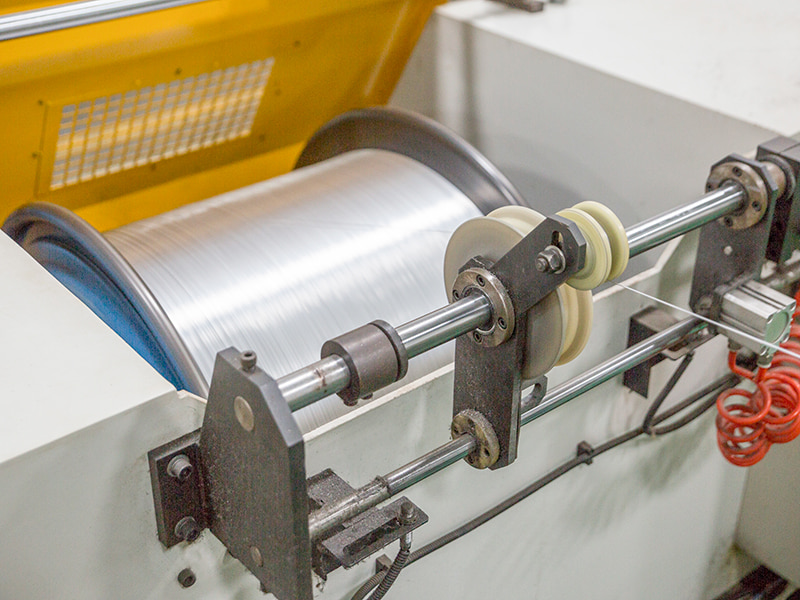Comprehensive Guide to ER5356 Aluminum Welding Wire: Selection, Applications, and Welding Instructions
- 1 1. Introduction
- 2 2. What is ER5356 Aluminum Welding Wire?
- 3 3. MIG Welding Applications of Aluminum Wire
- 4
- 5 4. ER5356 Aluminum Welding Wire Specifications and Selection
- 6 5. Application Fields
- 7 6. Wire Selection Guide
- 8 7. Welding Techniques and Considerations
- 9 8. Summary and Recommendations
- 10
- 11 FAQ
1. Introduction
In modern industrial manufacturing, aluminum is widely used due to its lightweight, high strength, and corrosion resistance. In aluminum processing and manufacturing, welding technology plays a crucial role. ER5356 Aluminum Welding Wire is an essential material for aluminum alloy welding, known for its excellent welding performance and reliable physical properties.
ER5356 Aluminum Welding Wire is especially suitable for welding magnesium-containing aluminum alloys (such as 5xxx series). It features excellent corrosion resistance, high strength, and stable weldability. Compared to other common aluminum welding wires, ER5356 stands out in key performance areas:
| Parameter | ER5356 Aluminum Welding Wire | General Aluminum Welding Wire (e.g., ER4043) |
| Magnesium Content | 4.5–5.5% | 4–5% |
| Strength | High, suitable for structural welding | Medium, suitable for decorative welding |
| Corrosion Resistance | Excellent, ideal for marine and outdoor environments | General, suitable for indoor or dry environments |
| Weldability | Good, suitable for TIG and MIG welding | Good, prone to cracking |
| Hot Cracking Tendency | Low | High |
With the increasing demand for lightweight design and corrosion resistance, ER5356 Aluminum Welding Wire is widely used in shipbuilding, automotive, aerospace, and lightweight architectural structures. Its excellent performance improves welding efficiency and ensures long-term stability of welded structures.
Therefore, understanding the properties, application range, and selection methods of ER5356 Aluminum Welding Wire is highly valuable for engineers, welders, and aluminum manufacturing professionals.
2. What is ER5356 Aluminum Welding Wire?
ER5356 Aluminum Welding Wire is a welding wire specifically designed for aluminum alloy welding, mainly used for 5xxx series aluminum alloys (magnesium-aluminum alloys). Its main advantages include high strength, excellent corrosion resistance, and good weldability, making it widely used in industrial manufacturing.
1. Chemical Composition
| Element | Content Range |
| Aluminum (Al) | Balance |
| Magnesium (Mg) | 4.5–5.5% |
| Manganese (Mn) | ≤0.3% |
| Chromium (Cr) | 0.2–0.35% |
| Silicon (Si) | ≤0.25% |
| Copper (Cu) | ≤0.1% |
| Iron (Fe) | ≤0.4% |
The high magnesium content gives ER5356 Aluminum Welding Wire high strength and excellent corrosion resistance, especially suitable for outdoor and marine environments.
2. Physical and Mechanical Properties
| Performance | Value |
| Yield Strength | 150–230 MPa |
| Tensile Strength | 280–320 MPa |
| Elongation | 8–12% |
| Melting Point | 565–645℃ |
| Density | 2.66 g/cm³ |
3. Comparison with Other Aluminum Wires
| Parameter | ER5356 Aluminum Welding Wire | ER4043 Aluminum Welding Wire |
| Magnesium Content | 4.5–5.5% | 4–5% |
| Strength | High, suitable for structural welding | Medium, suitable for decorative welding |
| Corrosion Resistance | Excellent, ideal for marine environments | General, better for indoor use |
| Weldability | Good, suitable for TIG and MIG | Good, prone to cracking |
| Hot Cracking Tendency | Low | High |
4. Application Range
- Shipbuilding: high corrosion resistance in marine environments
- Automotive: lightweight body and structural welding
- Architectural structures: aluminum roofs, curtain walls
- Aerospace and high-end machinery: load-bearing structural welding
3. MIG Welding Applications of Aluminum Wire
ER5356 Aluminum Welding Wire is commonly used in MIG (Metal Inert Gas) welding for aluminum. MIG welding is widely applied due to its easy operation, fast welding speed, and high-quality welds.
1. MIG Welding Overview
MIG welding uses inert gas (usually argon or helium-argon mixtures) to protect the welding area from oxidation. For aluminum, MIG welding can achieve:
- Smooth weld deposition
- Excellent appearance quality
- Good penetration and joint strength
With its high magnesium content, ER5356 Aluminum Welding Wire reduces hot cracking tendency and improves structural reliability.
2. Advantages in MIG Welding
| Indicator | Value / Feature |
| Welding Current | 80–250 A (adjust according to wire diameter and thickness) |
| Voltage Range | 18–28 V |
| Welding Speed | 20–40 cm/min (depending on thickness) |
| Weld Tensile Strength | 280–320 MPa |
| Deposition Rate | High, good efficiency |
| Hot Cracking Tendency | Low, suitable for thick plates |
3. Common Applications
- Shipbuilding: hull and deck welding, high salt corrosion resistance
- Automotive: body frame and lightweight parts, enhancing strength and reducing weight
- Aerospace and high-end machinery: load-bearing structural welding, ensuring safety
- Lightweight architectural structures: curtain walls and roofs, high weather resistance
4. MIG Welding Considerations
- Use appropriate inert gas protection (pure argon or helium-argon mix)
- Match wire diameter with welding current to avoid burn-through or incomplete penetration
- Control welding speed to ensure smooth and pore-free welds
- Clean aluminum surfaces before welding to remove oxide and grease
4. ER5356 Aluminum Welding Wire Specifications and Selection
| Wire Diameter | Applicable Thickness | Welding Method | Notes |
| 0.8 mm | 0.5–2 mm | MIG/TIG | Thin sheet welding, fine welds |
| 0.9 mm | 1–3 mm | MIG/TIG | General purpose, wide application |
| 1.2 mm | 2–6 mm | MIG/TIG | Medium thickness, high efficiency |
| 1.6 mm | 4–10 mm | MIG/TIG | Thick plate, good penetration |
Selection Principles
- Based on thickness: ≤2 mm use 0.8–0.9 mm, 2–6 mm use 1.2 mm, >6 mm use 1.6 mm
- Match welding method: MIG 0.8–1.2 mm, TIG 0.8–1.6 mm
- Balance efficiency and weld quality: thicker wires allow higher deposition rate but thin sheets may burn through
Other Considerations
- Corrosion requirements: high magnesium content ensures corrosion resistance
- Welding position: horizontal and vertical require different wire feed speeds
- Prevention of defects: clean wire and workpiece, proper shielding gas
5. Application Fields
1. Shipbuilding
Applications: hull plates, deck, cabin structures. Advantages: high salt corrosion resistance, high weld strength. MIG welding with ER5356 Aluminum Welding Wire ensures smooth welds and uniform penetration.
2. Automotive
Applications: lightweight body frames, chassis, aluminum parts. Advantages: high-strength welds, reduced vehicle weight, corrosion resistance. Thin sheets use 0.8–0.9 mm wire for precise and aesthetic welds.
3. Aerospace and High-End Machinery
Applications: load-bearing structures, brackets. Advantages: excellent weld strength, low hot cracking tendency, long-term reliability. Medium to thick plates use 1.2–1.6 mm wire for full penetration.
4. Architectural Lightweight Structures
Applications: curtain walls, roofs, window frames. Advantages: aesthetic welds, high weather resistance. Use MIG or TIG welding with 0.8–1.2 mm wire depending on plate thickness.
5. Other Special Fields
- Tanks and pipelines: high corrosion resistance and strength
- Lightweight transport: bicycles, motorcycles aluminum parts
6. Wire Selection Guide
- Material type: 5xxx series aluminum alloys (e.g., 5052, 5083, 5754)
- Thickness: ≤2 mm use 0.8–0.9 mm, 2–6 mm use 1.2 mm, >6 mm use 1.6 mm
- Welding method: MIG 0.8–1.6 mm, TIG 0.8–1.2 mm
- Corrosion resistance: use ER5356 in marine/high humidity environments
- Strength requirements: thicker wires for load-bearing structures
7. Welding Techniques and Considerations
1. Preparation
- Clean surface: remove oil, oxide, dust
- Check equipment: set correct voltage/current, check gas flow
- Parameter setting: match current with wire diameter
2. Welding Techniques
- Gun angle: 10–15° for uniform penetration
- Speed control: thin sheets slower, thick sheets faster or multi-pass
- Multi-pass: clean oxide between layers
- Start/End: gradual current reduction
3. Common Problems and Solutions
| Problem | Possible Cause | Solution |
| Porosity | Dirty surface or insufficient shielding gas | Clean surface/wire, increase gas flow |
| Cracks | High stress, thin sheet, fast cooling | Multi-pass, control speed, select appropriate wire diameter |
| Undercut | Excess current or fast travel | Adjust current or slow down |
| Rough surface | Uneven speed or unstable gas | Stabilize speed and gas flow |
4. Safety
- Wear protective gear: goggles, gloves, protective clothing
- Ensure ventilation
- Avoid overheating material or wire
8. Summary and Recommendations
- Core features: high magnesium, excellent corrosion resistance, good weldability, high strength, 0.8–1.6 mm range
- Applications: shipbuilding, automotive, aerospace, architecture
- Wire selection: thin sheet 0.8–0.9 mm, medium 1.2 mm, thick 1.6 mm
- Welding: MIG and TIG, control speed, gun angle, multi-pass, clean surface
- Use in marine/high humidity: ER5356 ensures long-term corrosion resistance
Proper selection and use of ER5356 Aluminum Welding Wire improves welding quality, weld strength, and corrosion resistance, meeting industrial requirements across multiple sectors.
FAQ
FAQ 1: What is ER5356 Aluminum Welding Wire and which aluminum alloys is it suitable for?
Answer:
ER5356 Aluminum Welding Wire is a high-magnesium aluminum alloy welding wire designed for 5xxx series aluminum alloys (e.g., 5052, 5083, 5754). It features high strength, excellent corrosion resistance, and low hot cracking tendency, suitable for shipbuilding, automotive, aerospace, and lightweight architectural structures.
Hangzhou Kunli welding materials Co., Ltd. is a high-tech enterprise specializing in high-performance aluminum alloy welding wire. With over 20 years of production experience and advanced equipment, it provides stable, high-quality ER5356 Aluminum Welding Wire for various industrial applications.
FAQ 2: How to choose the appropriate ER5356 Aluminum Welding Wire?
Answer:
Select ER5356 Aluminum Welding Wire based on material thickness, welding method, and weld strength requirements:
- Thin sheets (≤2 mm): 0.8–0.9 mm
- Medium thickness (2–6 mm): 1.2 mm
- Thick sheets (>6 mm): 1.6 mm
MIG and TIG welding are suitable, with parameters matched to wire diameter.
Hangzhou Kunli welding materials Co., Ltd. provides 0.8–1.6 mm ER5356 Aluminum Welding Wire, certified by DB, CE, ABS, DNV, CCS, with monthly production over 200MT, exported to 30+ countries, meeting diverse customer needs.
FAQ 3: What welding techniques and precautions should be considered when using ER5356 Aluminum Welding Wire?
Answer:
Consider the following when using ER5356 Aluminum Welding Wire:
- Preparation: clean surfaces, check equipment, set parameters
- Welding techniques: maintain gun angle, control speed, use multi-pass for thick plates
- Safety: wear protective gear, ensure ventilation, avoid overheating
Hangzhou Kunli welding materials Co., Ltd. has advanced production and testing equipment, cooperating with research institutes, providing reliable, high-performance ER5356 Aluminum Welding Wire for strong, corrosion-resistant, and aesthetically pleasing welds.
NEXT:ER4043 Silicon Aluminum Welding Wire Comprehensive Guide and Applications
Related Products
-
 View More
View More
5154 Aluminum Alloy Welding Wire
-
 View More
View More
ER4043 Silicon Aluminum Welding Wire
-
 View More
View More
ER4047 Aluminum Mig Welding Wire
-
 View More
View More
ER5154 Al-Mg Alloy Wire
-
 View More
View More
ER5087 Magnesium Aluminum Welding Wire
-
 View More
View More
Aluminum Welding Wire ER5183
-
 View More
View More
ER5356 Aluminum Welding Wire
-
 View More
View More
ER5554 Aluminum Welding Wire
-
 View More
View More
ER5556 Aluminum Welding Wire
-
 View More
View More
ER1100 Aluminum Welding Wire
-
 View More
View More
ER5754 Aluminum Welding Wire
-
 View More
View More
ER2319 Aluminum Welding Wire
 English
English Deutsch
Deutsch
 English
English Deutsch
Deutsch



